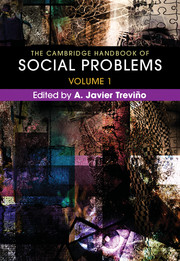Book contents
- The Cambridge Handbook of Social Problems
- The Cambridge Handbook of Social Problems
- Copyright page
- Contents
- About the Contributors
- Introduction
- Part I General Concerns and Orientations in the Study of Social Problems
- Part II Historical and Theoretical Issues in the Study of Social Problems
- Part III Problems of Discrimination and Inequality
- Chapter 17 Racism
- Chapter 18 Immigration
- Chapter 19 Gender Inequality
- Chapter 20 Sexualities and Homophobia
- Chapter 21 Poverty and Income Inequality: A Cross-National Perspective on Social Citizenship
- Chapter 22 Housing Market Discrimination
- Chapter 23 Hunger and Food Insecurity
- Chapter 24 Ageism, Past and Present
- Chapter 25 Disabilities
- Part IV Problems of Institutions
- Index
- References
Chapter 25 - Disabilities
from Part III - Problems of Discrimination and Inequality
Published online by Cambridge University Press: 16 March 2018
- The Cambridge Handbook of Social Problems
- The Cambridge Handbook of Social Problems
- Copyright page
- Contents
- About the Contributors
- Introduction
- Part I General Concerns and Orientations in the Study of Social Problems
- Part II Historical and Theoretical Issues in the Study of Social Problems
- Part III Problems of Discrimination and Inequality
- Chapter 17 Racism
- Chapter 18 Immigration
- Chapter 19 Gender Inequality
- Chapter 20 Sexualities and Homophobia
- Chapter 21 Poverty and Income Inequality: A Cross-National Perspective on Social Citizenship
- Chapter 22 Housing Market Discrimination
- Chapter 23 Hunger and Food Insecurity
- Chapter 24 Ageism, Past and Present
- Chapter 25 Disabilities
- Part IV Problems of Institutions
- Index
- References
Summary
This chapter begins with a consideration of disability as a form of social inequality as opposed to a purely medical condition. Following a relatively brief history of social understandings of disability, this chapter then charts the emergence of disability studies as a stand-alone discipline. Finally, because scholarship within the field of disability studies has predominantly focused on issues associated with physical disability, this chapter concludes by drawing on work concerning psychiatric disability to illustrate several consequences of this underinclusion and discusses challenges in incorporating physical, psychological, and intellectual conditions into a more universal conception of disability.
- Type
- Chapter
- Information
- The Cambridge Handbook of Social Problems , pp. 459 - 474Publisher: Cambridge University PressPrint publication year: 2018



